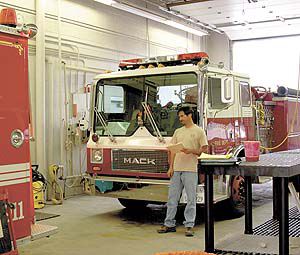| Carbon County fire warden Rudy Sandoval checks equipment at the Helper Fire Department to certify it for state standards. |
Working into the evening hours on April 17 local fire officials Rudy Sandoval, Fire Warden for Carbon/Emery County Fire and Ernie Salazar, Division of Forestry, inspected fire equipment in the city of Helper to ensure its compliance with new state requirements.
According to Sandoval the inspections are just one of several steps that will make Helper and other cities within the county eligible for reimbursement available for wildland fire suppression services outside of their jurisdictional responsibility. Meaning cities would receive monetary reimbursement for their participation in fires on state and federal lands in Carbon County.
Sandoval further reports that other requirements needed to obtain funds are personnel certification as Wildland Firefighter I and the expectation of a minimum engine inventory.
“All local city departments in Carbon and Emery counties are currently in the process of completing these requirements,” said Sandoval.
The Emery city departments will begin training on April 25 and finish on May 19. In Carbon County courses will begin on May 16 and run through June 9. All participants will be required to finish the 40 hour training course for qualification.
According to Sandoval an arduous fitness test will be required for those firefighters engaging in direct fire suppression, or in direct supervision of a wildland fire.
“I really want to let these guys know how much I appreciate their dedication and service to their cities and towns. They work long, hard hours and they do so to make both firefighting and our communities a safer place,” stated Sandoval.
Along with the state reimbursement program local fire officials have also been working on the creation of a Community Wildfire Protection Plan. The plan is a part of the Healthy Forests Restoration Act of 2003 which provides statutory incentives for the U.S. Forest Service and the Bureau of Land management to give consideration to the priorities of local communities as they develop and implement forest management and hazardous fuel reduction projects.
This legislation will provide local communities with an opportunity to influence where and how federal agencies implement fuel reduction projects on federal lands and how additional federal funds may be distributed for projects on non federal lands.
“All current projects will benefit the safety of our community vastly,” concluded Sandoval.

